An Interview with Frog the What Games – Slaughterball!
September 28, 2014 by dracs
Frog the What Games recently took to Kickstarter to help fund their exciting new scifi game of genetically engineered football named Slaughterball! I managed to get a chat with the game's creator Erik Kjerland about just what is going on in this game of sporting slaughter, and he even brought an exclusive image to show us. Read on to find out more.
Me: I am joined by Erik of Frog the What Games (not as I kept mistakenly calling it What the Frog Games. Oops) and he is here to tell us a bit more about his new game Slaughterball. So Erik, thank you for joining us.
Erik: Thank you Sam for interviewing me.
Me: No worries. First can you tell us a bit about yourself and your experience in gaming. How did you get started?
Erik: I guess the first gaming experience I had was as a kid, you know playing Scrabble, Bobble, and Monopoly, but then quickly got into Dungeons and Dragons. From there I got into a whole bunch of board games and computer games. I always liked Blood Bowl, of course, one of my favourites, and other games such as... well what's my favourite game right now? I guess, Lords of Waterdeep. I also got into miniatures games, I played a bunch of the Dead Lands miniatures games, and things like that. I like strategy, Risk-type games with rolling dice.
Me: Have you tried Risk Legacy yet?
Erik: I haven't, I got Risk 2210, but I haven't got into Legacy. That came out after I started designing Slaughterball, so I haven't had much time to pick that one up.
Me: 2210 is excellent as well, just take the Moon.
Erik: Yes!
Me: How did you go from being a gamer to a developer, how did you make that leap?
Erik: Well, first I was always the dungeon master in role play games, so I would design my own adventures, and then when I started getting into boards games I would play games such as Settlers of Catan and play that for a while, then I would go "Oh wouldn't it be cool if you could do this?" So I created my own add-on rules for games that existed. From there I started getting into designing my own games, and it would just be for me and friends, kinda like a hobby. Like I created a game where you controlled a gang and you fought other gangs, and then a fantasy conquest game, and a couple of others, but they were all just hobbies and that's how I got started.
Me: Excellent, and now you're here with Slaughterball and a very successful Kickstarter going on.
Erik. Hooray! Yes, yes, we're very happy!.
Me: And so you should be. Can you tell us a bit more about Slaughterball, can you give us an idea of the background?
Erik: Sure, sure, let's see. Well I guess the inspiration for Slaughterball came from the old PC-game from Bitmap Brothers called Speedball. I played the heck out of that thing back when it came out, what was that late 80s? I liked the concept of a futuristic blood sport, but in this shiny, stainless steel arena where you score points for injuring opponents. I've always liked that, and also movies like Rollerball are an inspiration. So when I found Kickstarter and I saw these board games succeed I realised "Hey, that's feasible, I can actually try and fund it that way," because getting a board game into a publisher, having them produce it for you is very difficult. I said, "you know what? I'm going to try and develop a board game using Kickstarter" and I chose Slaughterball first because it was my favourite that I had in development at that time.
Me: I read earlier that you based the background of this on a book you had written earlier, is that right?
Erik: Yes it is, I also write novels under the pen name Derek J. Canyon. I had written a futuristic cyberpunk novel called Dead Dwarves Don't Dance.
Me: (laughing) OK, that's brilliant!
Erik: That's about a genetically engineered dwarf assassin seeking redemption.
Me: You had me at genetically engineered dwarf.
Erik: (laughing) yes, lots of people say that, dwarves are very popular. Anyway I wrote that book several years ago, and I liked the genetic engineering in it. So I thought "What would sports be like in that universe?" Well they'd be genetically engineered super-athletes, you know the fast guys would have double-kneed legs so they can jump and run faster, and some of them would have four arms, and some of them would look like the Hulk. There's really no limit to what sort of genetically engineered neo-human can be created. Perfect for the different teams' themes. I just went with that and now they're in the same universe.
Me: Slaughterball is all in one box isn't it?
Erik: Correct, at the $100 pledge level you get four complete teams that give you everything you need to play any of the three game modes that come in the box. That's the basic learning mode called Scrimmage, Exhibition Mode where you have asymmetrical pro-teams, and then there's League where you can play over a full season and improve your athletes over time.
Me: Oh, so it's got an evolving campaign system as well?
Erik: Oh yes. You play the League which has a default of ten games for each team and you earn money after each game, which you can then spend on improving your athletes skills and traits. There are over 50 skills to choose from.
Me: Excellent, I love campaign systems as it helps you get really invested in your faction or team.
Erik: Oh yes, whenever I have money for winning a game and I look through all the skills and there are some in there that I have to get all the time.
Me: Can you tell us a bit more about the four teams?
Erik: Sure! Well there are 52 miniatures that come in the box and that includes four teams and four mavericks, those are kinda like the free agents.
There is the team Carnage and they are genetically engineered to resemble orcs, goblins and ogres, and they concentrate on basically clobbering everyone else. They're big and mean and have skills that enhance those abilities.
The next team is team Nemesis. They're the blue team with a sleek Tron-like look. They're the strategy team, they have skills that let them hold more strategy cards and also cancel strategy cards of their opponents. So whenever you go up against Nemesis you have to watch out as they can really mess with your plans.
Me: When the other BoW guys read this; dibs on that team!
Erik: (laughing) Yeah I was surprised, they're a very popular team, I thought people would really like the next team, which is Swords of Damocles.
They're like the Greek Spartan looking team, concentrating on throwing, passing and shooting. You really have to watch out for those guys as if they get the ball, it's conceivable for them to just make three goals in a row in one turn. When you're up against them you really want to injure their razor athletes, which are the quarterbacks.
Me: And what about the final yellow team?
Erik: The yellow team are the Valkyries and their your basic gorgeous, Nordic warrior woman type, but their skills let them manipulate other teams. If they sacrifice a card they can move other athletes wherever they want.
One of the things they really like doing is luring athletes into the centre of the board into what is called the Meat Grinder. If you get knocked down there you're more likely to get injured so that can leave you in big trouble.
Me: OK, that sounds cool, I love the idea of this meat grinder in the middle.
Erik: Yes, yes. That came about because when I first designed the game the ball would shoot out of the launchers and someone would grab it and they'd just start scoring. That didn't provide enough interaction at the start of the game. So I thought "What if there's this spot in the middle of the field where you have to go to open the goals." So that promotes more interaction at the start of the game. And then I thought "What if that's a dangerous spot where you can get crunched to bits?"
Me: That is a really good mechanic, this should add a whole new level of dynamism to the game.
Erik: Thank you, that was my plan.
Me: Can you let us know a bit more about the gameplay?
Erik: Whoever has the most points at the end of six rounds wins. During each round each coach gets their turn and on your turn you get three activation tokens, which you can use to tell three of your six athletes to do something on your turn. So part of the strategic issue you have is "Which three do I choose?"
In the basic Scrimmage game you have three actions to choose from and those are move, shoot a goal, pass, and chop an opponent. When moving you just look at your speed trait, and that's how many spaces you can move. For the other actions you have to roll dice.
Me: Slaughterball uses custom dice, what do each of the symbols represent?
Eric: Well knives are basically success symbols, so if you want to do something you just count how many dice you get. So if you wanted to attack an opponent you would basically roll on your brawl and whoever got the most dice wins. Next is star, which is used to power up skills in the advanced games. Like with the skill star shooter you can count the star as a knife. Then the boot is for movement based skills. Finally there is the the skull. In the current game I think there is only one character which uses the skull, but in future expansions that is going to power up things like equipment.
Me: You mentioned exclusives and I've been looking through the Kickstarter at some of these. You have some superb models for each of the teams, but it's the exclusives that really stand out for me.
You've got an exclusive Sandy Petersen mini, the creator of Call of Cthulhu.
You also have Tom Vasel, from the Dice Tower.
And Angry Joe, who I'm a big fan of. I think you've got him down perfectly in the miniature.
Erik: He helped me a lot figuring out what he wanted to look like. He'll actually be doing a Twitch stream playing the game before the end of the Kickstarter.
Me: Excellent, I'll look forward to that. And you've sent us the colour image for this mini, so thanks a lot for that.
Erik: You're welcome, that's an exclusive for you guys!
Me: See that guys? You want to see Angry Joe in colour? First here on Beasts of War.
Now there have been plenty of tabletop football games in the past, how do you think Slaughterball really stands out from these?
Erik: Well, first thing is I decided to go with large miniature scale, because I liked the feel and heft of larger minis. These guys are between 40-42mm, which should also let you get some really good paint jobs if you want to paint your guys up.
The other difference is I think that Slaughterball is the most immersive because of the great artwork. If you look at the game board it's got futuristic advertising on the walls, which really emulates the glitz and glory of a futuristic sport. There's blood on the field, bits of popcorn lying everywhere, there's ice cream in the medical area, just lots of theme.
And finally it's really easy to pick up. I don't know if you've heard of the game Battleball?
Me: Er, no afraid not.
Erik: Well that was a very simple game. It was easy to pick up and I enjoyed it as well, but it didn't have enough depth for me. I would say Slaughterball is definitely easier to pick up than Blood Bowl and Dreadball. We were able to teach the game at conventions in fifteen minutes and get a full two player game with new players in an hour.
So it's the ease of play, the awesome miniatures and the theme that sets it apart.
Me: I just spotted another of those awesome miniature designs. How did I miss this one, Luly.
Erik: (laughing). Yes, no relation to anyone else.
Me: Of course not. Does she have a multipass?
Erik: Yes, yes she does, that is one of the names of her skills. Here's her reference card.
I have about twenty of those Maverick type players planned and the first four you'll definitely see resemblances to science fiction characters you might know. All of those types of Mavericks are included in the Butcher pledge.
Me: What has the creative process behind this been like and what challenges have you faced?
Erik: Ooh, the creative process has been very long. I have been working on this diligently for four years. But you know getting off from work, coming home and working on the rules and play testing, that I just enjoy a lot. I really enjoy designing games, so it doesn't feel like a job when I actually doing the design and development part. The difficult part for me is in doing the business side of things, hunting down artists and doing the book keeping, but as far as the designing part goes, sitting down and dreaming up rules and play testing with people and seeing their responses is really fun. The only problem is it takes so long. Since I have a day job it has taken four years to get to this point and I just wish someday I could do this as my official job.
Me: That's the dream mate. What's your experience with Kickstarter been like?
Erik: Well first of all I love it to death as without it I couldn't do this, I couldn't get my game published. And now it will be published, woohoo! Other than that, as a small start up company it's very hard figure out what sort of advertising and promotions will work to get this in front of people's eyeballs. Sometimes it's like pulling hairs, how do those other small companies get those big boosts at the end of the campaign? That's what we're trying to figure out and how can we get more people to see this? If any of your readers have any suggestions I would love to hear them. Of course we're advertising on Beasts of War, but I might be missing something so I would really like to hear if anyone else has any ideas.
Me: You read that guys, go forth and spread the word of Slaughterball. Last of all, do you have anything else in store for us in the future?
Erik: Oh boy. Well you know how I said I design games for me and my friends as a hobby? We have two other games in the early prototype stages, and then I have seven other games in my head. So I have enough work for the next probably twelve to fourteen years if I wanted to.
Now, for short term I've got four additional teams for Slaughterball that are fully play tested and being unlocked with stretch goals. Then I have eight more teams currently in play testing for future expansions. I also have ideas for additional rules, like equipment, performance enhancing drugs, stuff like that. Also mascots, cheerleaders and fan involvement. Definitely enough for another expansion, but those haven't been fleshed out yet, I look forward to getting to those after we have this Kickstarter in the can.
Me: Can you give us a hint about one of those future teams?
Erik: Well if you go on the Kickstarter and check out the updates you'll find the mid-season report with the ranking league for all the playtesting games. But there's one which seems to be getting a lot of attention, called Doom. They are a team of genetically engineered super-athlete rabbits.
Me: (burst out laughing)
Erik: They have a skill called Death From Above, so they can leap up and come down on you and deal a lot of damage that way.
Me: They sound fantastic.
Erik: And there are others like the Pirate team and Dog team, lots of options in this universe. Also the fans on Board Game Geek have started a suggestion thread for me with things like an insect team and a centaur team, so we'll see what we can do and what makes sense. I just want to make sure things fit with the universe and aren't too silly. Slaughterball definitely takes a more serious and realistic tack in that I just want to make sure that no team doesn't seem to fit.
Me: Well, the great thing about your genetically engineered teams is that it pretty much opens up the game to anything you can imagine.
Erik: Yes it really unleashes the game's potential.
Me: It unleashes the beast. Like Simba Khan.
Erik: Oh yeah, I cannot wait to see the paint jobs on him, that's my favourite model in the first set.
Me: I'm sure we can't wait to see it either.
Erik: Yeah, you have your own good painters at Beasts of War don't you?
Me: Romain is our resident artiste, aye.
Erik: Well when I get my pre-production copies I will have to send one over to Beasts of War so guys can check it out and give it a play.
Me: That would be brilliant, I'll definitely look forward to that.
Erik: I've taken this to three conventions and demoed it, the Dragonflight Board Game Convention, Pax Prime over in Seattle, and then another one called the Rose City Comic Con in Portland, and I do demo games. I am so happy to find that the people who play, I think it's 100%, love the game. It's really fun and easy to get into, so I'm looking forward to getting it in stores as I think once people have played it they will like it and want to get more of it.
Me: Well that's all, thanks a lot for joining me Erik.
Erik: Thanks so much to you, I really appreciate this opportunity.
If all this has you intrigued and you want to find out more about Erik's game of scifi blood sports, check out the Slaughterball web page and be sure to head over and check out their Kickstarter campaign.
Which team will you choose?
Supported by (Turn Off)
Supported by (Turn Off)
Supported by (Turn Off)










































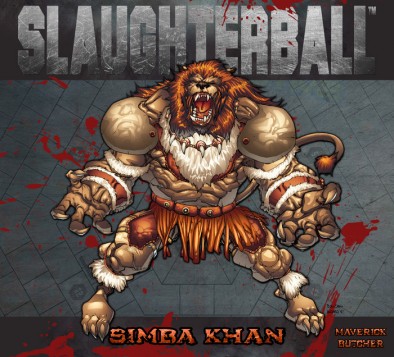

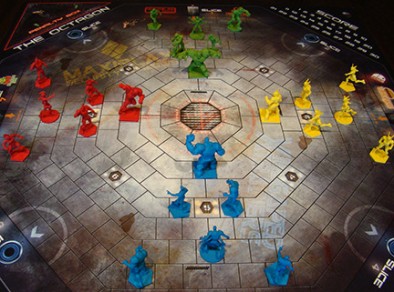
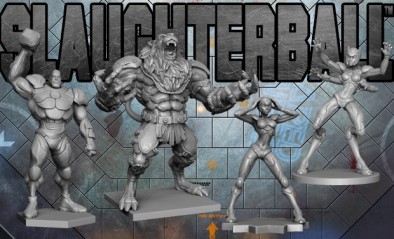
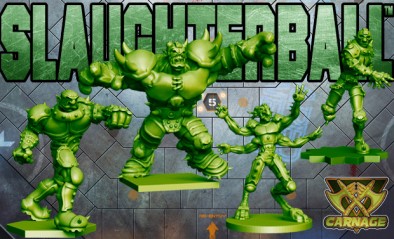
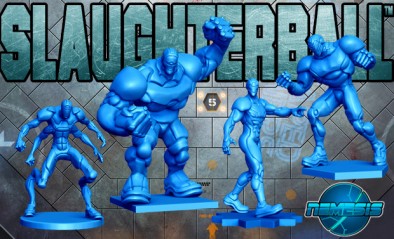
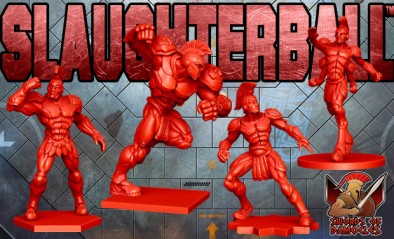

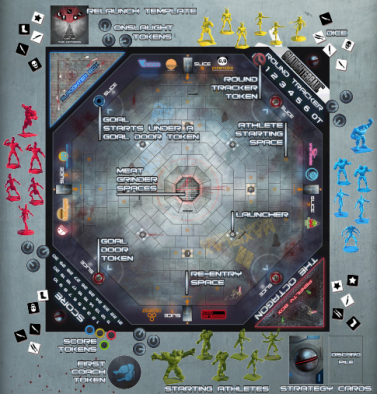
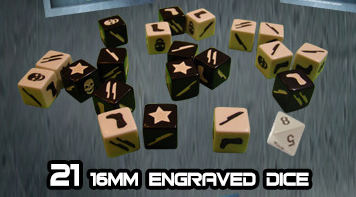
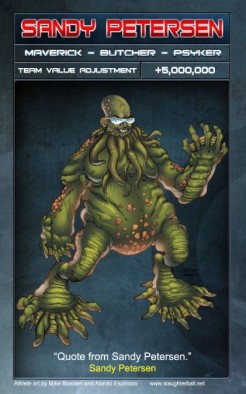
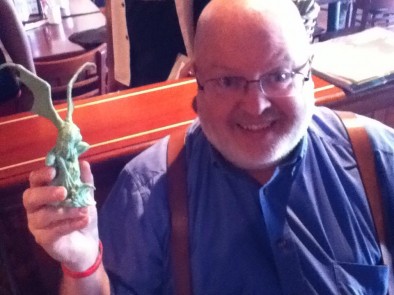
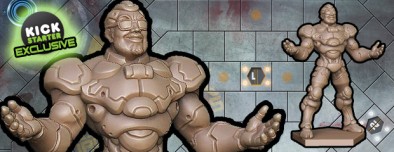
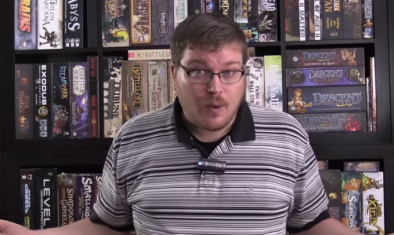
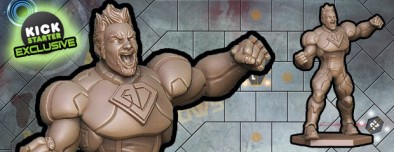
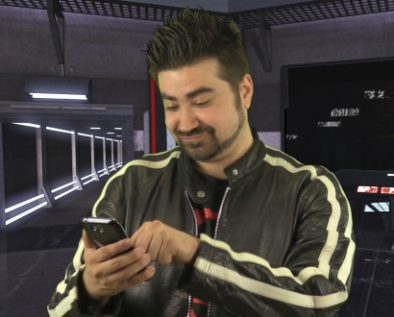
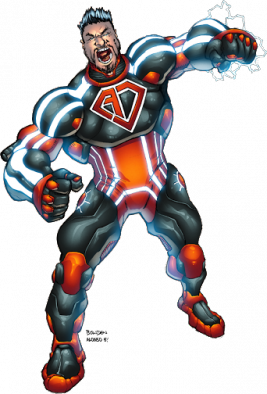

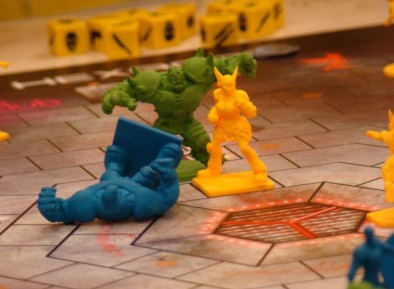
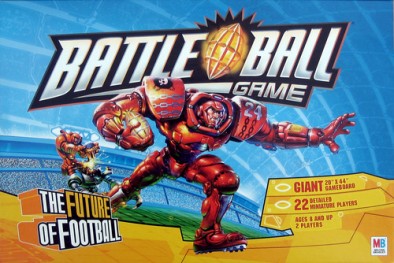
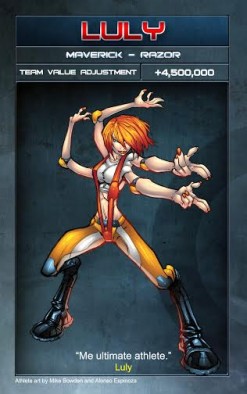
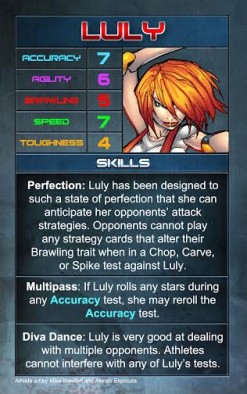
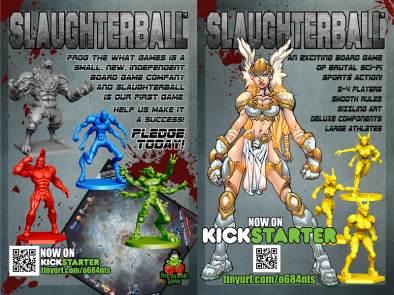
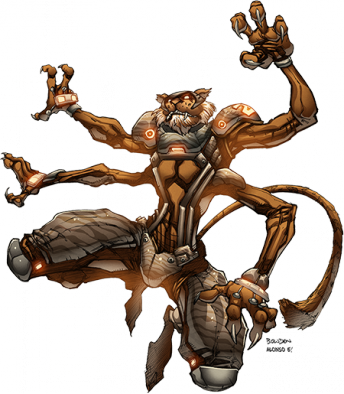

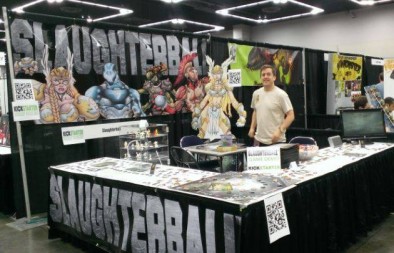


































Sam,
Thanks a lot for the opportunity to do the interview! I had a blast! If anyone has any more questions, don’t hesitate to ask me.
Stay crunchy!
Erik Kjerland
Designer of Slaughterball
Co-owner of Frog the What Games
http://www.slaughterball.net
No worries Erik, was great to talk to you. I hope the demo game you mentioned after went well.
That Simba Khan model is great. I’d field an entire team of just him 😛
manpug, you’re in luck. They just unlocked Team Fury, an entire team of lion/tiger/panther men.